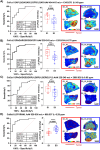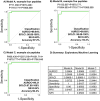The Spatial Extracellular Proteomic Tumor Microenvironment Distinguishes Molecular Subtypes of Hepatocellular Carcinoma
- PMID: 38980715
- PMCID: PMC11385377
- DOI: 10.1021/acs.jproteome.4c00099
The Spatial Extracellular Proteomic Tumor Microenvironment Distinguishes Molecular Subtypes of Hepatocellular Carcinoma
Abstract
Hepatocellular carcinoma (HCC) mortality rates continue to increase faster than those of other cancer types due to high heterogeneity, which limits diagnosis and treatment. Pathological and molecular subtyping have identified that HCC tumors with poor outcomes are characterized by intratumoral collagenous accumulation. However, the translational and post-translational regulation of tumor collagen, which is critical to the outcome, remains largely unknown. Here, we investigate the spatial extracellular proteome to understand the differences associated with HCC tumors defined by Hoshida transcriptomic subtypes of poor outcome (Subtype 1; S1; n = 12) and better outcome (Subtype 3; S3; n = 24) that show differential stroma-regulated pathways. Collagen-targeted mass spectrometry imaging (MSI) with the same-tissue reference libraries, built from untargeted and targeted LC-MS/MS was used to spatially define the extracellular microenvironment from clinically-characterized, formalin-fixed, paraffin-embedded tissue sections. Collagen α-1(I) chain domains for discoidin-domain receptor and integrin binding showed distinctive spatial distribution within the tumor microenvironment. Hydroxylated proline (HYP)-containing peptides from the triple helical regions of fibrillar collagens distinguished S1 from S3 tumors. Exploratory machine learning on multiple peptides extracted from the tumor regions could distinguish S1 and S3 tumors (with an area under the receiver operating curve of ≥0.98; 95% confidence intervals between 0.976 and 1.00; and accuracies above 94%). An overall finding was that the extracellular microenvironment has a high potential to predict clinically relevant outcomes in HCC.
Keywords: cancer; collagen; extracellular matrix; hepatocellular carcinoma; mass spectrometry imaging; microenvironment; post-translational modification; proline hydroxylation; proteomics.
Conflict of interest statement
The authors declare the following competing financial interest(s): PMA serves as Advisory for GlycoPath and is shareholder for GlycoPath and N-zyme Scientifics. RRD serves as Advisory for GlycoPath and is shareholder for GlycoPath and N-zyme Scientifics. ASM serves as Advisory for GlycoPath, GlycoTest and is shareholder for GlycoPath, GlycoTest and N-zyme Scientifics. YH serves as Advisory for Helio Genomics, Alentis Therapeutics, Espervita Therapeutics, Roche Diagnostics, Elevar Therapeutics and is shareholder in Alentis Therapeutics, Espervita Therapeutics.
Figures






References
Publication types
MeSH terms
Substances
Grants and funding
- P30 DK123704/DK/NIDDK NIH HHS/United States
- U01 CA283935/CA/NCI NIH HHS/United States
- T32 GM132055/GM/NIGMS NIH HHS/United States
- R21 CA263464/CA/NCI NIH HHS/United States
- R01 CA253460/CA/NCI NIH HHS/United States
- P30 CA142543/CA/NCI NIH HHS/United States
- R01 CA292930/CA/NCI NIH HHS/United States
- S10 OD030212/OD/NIH HHS/United States
- R01 CA255621/CA/NCI NIH HHS/United States
- R01 CA282178/CA/NCI NIH HHS/United States
- S10 OD025126/OD/NIH HHS/United States
- U01 CA226052/CA/NCI NIH HHS/United States
- P30 CA138313/CA/NCI NIH HHS/United States
- P20 GM103542/GM/NIGMS NIH HHS/United States
- U01 CA288375/CA/NCI NIH HHS/United States
- S10 OD010731/OD/NIH HHS/United States
- R01 CA233794/CA/NCI NIH HHS/United States
LinkOut - more resources
Full Text Sources
Medical

